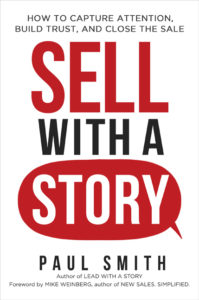Podcast: Play in new window | Download | Embed
Subscribe: RSS
Podcast (sell-with-a-story-series1): Play in new window | Download | Embed
Subscribe: RSS
 Nobody ever quit their job and started their own company for a boring reason.
Nobody ever quit their job and started their own company for a boring reason.
And that’s why one story every salesperson should have in their arsenal is their company’s founding story. It introduces the prospect to the person who started your company and helps them see and feel why it was started in the first place.
Understanding the passion that founder was pursuing helps the prospect see your company not just as an impersonal corporate machine, but as a collection of human beings on a mission. And that’s a company your prospect is much more likely to want to do business with.
So, let’s look at how that company story is typically written. And then see how we can make it even better.
Imagine you work for the active travel company Backroads. Consider the following two ways you might try to explain to someone who that company is and why it exists. Here’s Version A, written the way a lot of companies write their story:
Backroads is the world’s #1 active travel company. We’ve been in business for 38 years since our CEO, Tom Hale, founded the company in 1979. From our first trips in California, today we operate in 48 countries around the world. Each year, our 500 leaders take more than 29,000 guests on at least 2,000 exciting trips.
You could be hiking or biking or kayaking, but wherever you are, you won’t be bored. From our expert trip designers and engaging leaders to our skilled bike mechanics and stellar guest service team, quality is woven into the philosophy and fabric of our company. We call it guest focus, and we aim to be the most guest-focused company out there.
Okay, not bad. But a little boring. In fact, it sounds like something you’d expect to find on a glossy marketing brochure. Which is fine. You need marketing brochures. But what it doesn’t really sound like, is an interesting story. And that’s because the main character in this version is “the company” instead of the human being, Tom Hale, who founded the company. The other reason is that it doesn’t explain why he founded it.
So, to fix that, I called up Tom Hale, CEO of Backroads, and talked to him about why he started the company. I asked him about what he did before Backroads, why he was in that profession, why he left it, and what attracted him to the idea of starting an active travel company in the first place. We only talked about 45 minutes. The following is the story I came up with after that conversation. See if you can tell the difference in this one, which we’ll call version B:
When our founder, Tom Hale, was a kid, he wasn’t much of a fan of mass tourism. You know, big theme parks where people are shuffled around in herds and stand in line for hours just for a three-minute ride. He felt like he was trapped in an artificial, sedentary environment with a bunch of strangers.
Then when he grew up, his first job out of college was in a big office building in Las Vegas. Six months into it, he realized his job was a lot like those vacations he never liked as a kid: trapped in a huge artificial city, working long hours in the same spot, surrounded by lots of people he didn’t know.
Then one night he woke up at 2 a.m. with an idea. And by 8 o’clock the next morning, he’d sketched out a plan for a more exciting career for himself, and a better vacation experience for everyone else. And that’s when Backroads was born.
His idea was to thoughtfully plan out authentic, active, outdoor experiences, in naturally beautiful locations, in small groups that you help select. That way, whether you’re hiking, biking, kayaking, or something else, it’s never fake, you’ll never get bored, and you’ll always be among friends.
Now, notice what neither of these versions does. Neither does a great job of explaining exactly what Backroads actually does. That’s intentional. This isn’t your product story. We’ll cover that in the next episode.
The founding story is just supposed to introduce your prospects to your company and why it was started, and to do so in a way that’s interesting and leaves them wanting to know more. Version B does that better because it’s an actual story about Tom Hale’s life and the inciting moment that lead him to found the company. Version A doesn’t accomplish that nearly as well because it’s not even a story about Tom Hale, and it doesn’t explain why he founded the company.
Next steps: Does your company already have a compelling founding story like version B? If so, find it, read it, and keep it in your repertoire of sales stories to tell when the time is right.
But if not, then your challenge is to create one. Interview the founder of the company, or the person who knows that story the best. Ask enough questions to be able to craft a story like version B above. Write that story, add it to your repertoire, and share it with your coworkers. Your sales results will reflect it.
Use these links to subscribe to this podcast on iTunes or Stitcher, or Podbean.
Source: Sell with a Story: How to Capture Attention, Build Trust, and Close the Sale, by Paul Smith.
—
 Paul Smith is one of the world’s leading experts on business storytelling. He’s a keynote speaker, storytelling coach, and bestselling author of the books Lead with a Story, Parenting with a Story, and Sell with a Story.
Paul Smith is one of the world’s leading experts on business storytelling. He’s a keynote speaker, storytelling coach, and bestselling author of the books Lead with a Story, Parenting with a Story, and Sell with a Story.


 Connect with him via email here.
Connect with him via email here.
Follow him on Facebook, LinkedIn, Twitter, and Instagram.
Sign up for his newsletter here to get one new story a week delivered to your inbox.


[…] Example: During his pitches, Backroads CEO Tom Hale likes to tell the origin story of founding his travel company. Hale always disliked mass tourism, […]